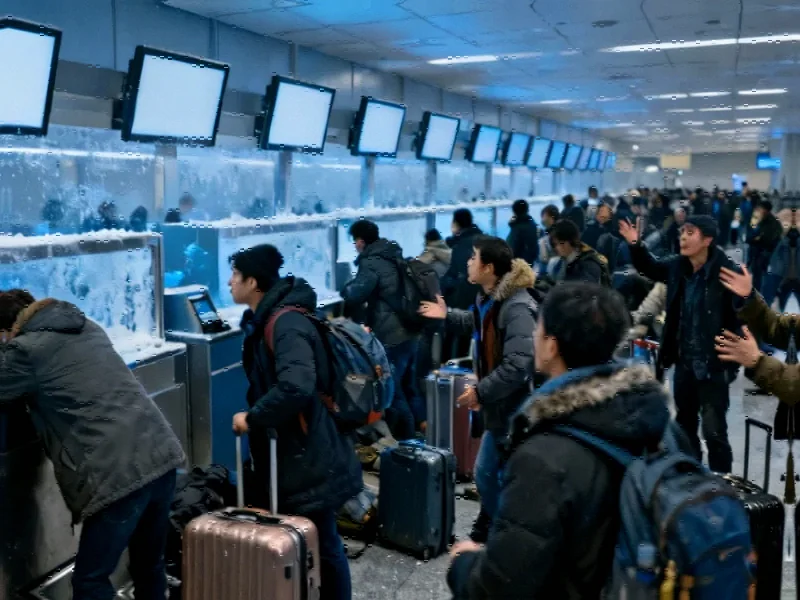The Domino Effect of Cloud Infrastructure Failure
When Amazon Web Services experienced a significant outage early Monday morning, the digital world witnessed a stark demonstration of modern infrastructure interdependence. The disruption affected more than 100 AWS services, creating a ripple effect that paralyzed everything from messaging platforms to airport operations across the globe. This incident serves as a critical case study in the vulnerabilities of our increasingly centralized digital ecosystem.
Critical Services Brought to Their Knees
The scale of disruption was immediately apparent across multiple sectors. Major communication platforms including WhatsApp, Signal, and Slack reported widespread service interruptions. Financial services like Venmo and Coinbase experienced downtime, while entertainment platforms including Hulu, Roblox, and Fortnite faced login and connectivity issues. Even government digital services weren’t immune, with the United Kingdom’s official website among those affected by the cascading failure.
According to detailed analysis of the major AWS disruption that crippled key online services, the incident revealed just how many critical systems depend on a handful of cloud providers. Amazon’s own ecosystem suffered collateral damage, with Ring security cameras and various Amazon services experiencing outages despite being part of the same infrastructure.
Airport Chaos and Travel Disruption
The most visible impact of the outage manifested at airports worldwide. United and Delta airlines saw their check-in systems fail, creating massive queues and operational headaches. Travelers reported being unable to check in for flights or process baggage drop-offs, with social media flooding with images of snaking lines at major airports.
United Airlines confirmed via official communications that their systems were impacted by the AWS outage, though the situation hadn’t yet escalated to widespread flight cancellations. Delta reported minor delays but maintained that their teams were working to minimize passenger impact. The timing couldn’t have been worse, coming amid an ongoing government shutdown that had already strained airport operations and left many workers without pay.
Technical Root Cause Analysis
Amazon’s initial investigation pointed to DNS resolution issues with their DynamoDB service as the primary culprit. The problem originated from a DynamoDB API endpoint in the US-EAST-1 region, which hosts substantial physical infrastructure in northern Virginia. This caused a cascade effect across services relying on the same regional infrastructure.
The core issue involved thousands of companies suddenly losing the ability to translate user-friendly domain names into machine-readable IP addresses. As one analysis of major AWS outage disrupting crypto exchanges and online services explained, this demonstrates how single points of failure in cloud architecture can have disproportionate effects across the digital landscape.
Broader Implications for Digital Infrastructure
This incident highlights growing concerns about concentration risk in cloud computing. When a handful of providers supply the backbone of global digital services, even minor technical glitches can create worldwide disruptions. The situation echoes previous infrastructure failures but occurs against a backdrop of increasing digital dependency across all sectors.
Recent industry developments in cloud computing have focused on redundancy and failover systems, yet Monday’s outage demonstrates that fundamental architectural vulnerabilities remain. As businesses continue their digital transformation journeys, understanding these dependencies becomes crucial for risk management and business continuity planning.
Comparative Impact Assessment
While disruptive, the AWS outage proved somewhat more contained than last year’s Crowdstrike incident that caused global aviation chaos and cost Delta Airlines approximately $500 million. The current outage began around 3 AM ET and saw the underlying issue “fully mitigated” by 10 AM ET, though full service restoration remained ongoing with only 37 of 114 affected services restored by that time.
This event occurs alongside other significant market trends affecting global technology infrastructure, including shifting investment patterns and evolving security concerns. The incident underscores why businesses must consider distributed architecture approaches rather than relying on single-provider solutions.
Future-Proofing Digital Infrastructure
The AWS outage serves as a wake-up call for organizations worldwide. As companies increasingly leverage AI tools transforming business strategy through automation and data analytics, understanding the underlying infrastructure dependencies becomes paramount. The communication breakdown between critical systems highlights the need for more resilient architectural approaches.
Meanwhile, global economic factors continue to influence technology investment decisions. As reports indicate China’s economic resilience tested amid slowing growth, and organizations note China’s market paradox of record capital inflows amidst uncertainty, the strategic importance of reliable digital infrastructure becomes increasingly clear. The current communication crisis fueling US-China trade tensions further complicates the global technology landscape.
Strategic Considerations for Industrial Computing
For industrial computing professionals, this incident underscores several critical considerations. The need for cultural shift required for digital transformation extends beyond mere technology adoption to encompass comprehensive risk assessment and business continuity planning. Organizations must evaluate their dependency on single cloud providers and consider hybrid or multi-cloud strategies to mitigate similar disruptions.
The rapid evolution of related innovations in edge computing and distributed architectures offers promising alternatives to centralized cloud models. As industrial systems become increasingly connected and dependent on cloud services, building resilience against such widespread outages must become a strategic priority rather than an afterthought.
Monday’s disruption, while temporary, provides valuable lessons about the fragile interconnectedness of our digital world and the urgent need for more robust, distributed infrastructure models that can withstand single points of failure while supporting continued digital transformation across all sectors.
This article aggregates information from publicly available sources. All trademarks and copyrights belong to their respective owners.
Note: Featured image is for illustrative purposes only and does not represent any specific product, service, or entity mentioned in this article.



